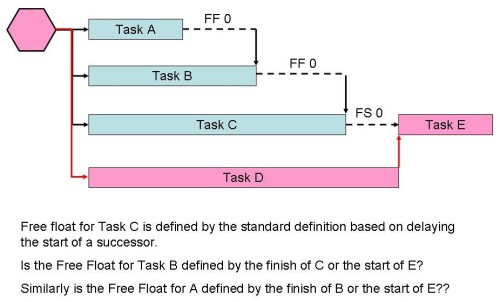The generally accepted definition of Free Float is found in the PMBOK® Guide the glossary definition is: Free Float The amount of time that a schedule activity can be delayed, without delaying the early start date of any successor or violating a schedule constraint. This post asks is this true or do we need a more precise definition?
The simple network above demonstrates the problem. Tasks A, B and C are connected Finish-to-Finish 0; C to E is Finish-to-Start 0. The Network is drawn to a time scale.
The traditional definition for Free Float works for Task C through the Finish-to-Start link.
The traditional definition for Free Float also works for Tasks A and B provided Tasks B and C respectively are defined as contiguous tasks, as soon as the completion of B or C is impacted, the start of the task is also impacted because the duration is fixed and there is no more Free Float.
However, if the tasks are non-contiguous, meaning the elapsed period between the start and the finish can be greater than the duration (stretchable is another term) we have a problem. The finish can be moved back without delaying the start. In this situation is the Free Float defined by delaying the Early Finish of the immediate successor, or does it cascade through to the start of Task E?
A similar problem occurs if there are actual start dates for any of the activities, once there is an actual start date it does not change regardless of what happens to the finish date.
Is a better definition for Free Float: The amount of time a schedule activity can be delayed without delaying the early start or finish date of any successor or violating a schedule constraint. This definition would limit the free float on task A by the Early Finish date of Task B regardless of the task type and/or progress information. But this is not the current definition.
At the moment I stick to the traditional definition in my comprehensive paper on PDM network calculations because this is part of the materials referenced in our PMI-SP courses and PMI uses the ‘old’ definition; see: http://www.mosaicprojects.com.au/PDF/Schedule_Calculations.pdf
Both options are discussed in our more technical paper on float calculations: http://www.mosaicprojects.com.au/PDF/Schedule_Float.pdf
What I will be very interested in hearing is the scheduling communities views on this topic – what is the correct definition and does it really matter??



Or maybe:
The amount of time a schedule activity can be delayed without ** changing the float** of any successor or violating a schedule constraint